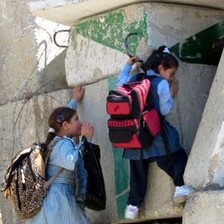East Jerusalem 21 March 2003

Demonstrators Confronting Israeli APC, Rafah
On the 18th of March three of Rachel Corrie’s friends from the International Solidarity Movement (ISM) were delivering her body to Tel Aviv as three friends and I entered the Gaza Strip. Her brutal murder by the Israeli solider, fortified in a bulldozer, was the first topic of discussion with community members from the Palestinian police officers who checked our passports to the children in south Rafah who live beside the place where Rachel was killed.
It took just over an hour, driving through shambles of Gaza’s streets which are all too familiar with death and violence, to reach the Rafah community center where a memorial service was taking place for Rachel. The walls in Rafah are now covered with her martyr posters and every passerby I spoke with mentioned how ‘terribly sorry we are for her death…we are honored she came to us.’ Flowered wreathes and commemorative banners were sent to the community center from elementary school classes, ministries of the Palestinian National Authority, and organizations such as the Palestinian Red Crescent Society. A group of fifteen schoolgirls beautifully sang while community members gave condolences to Rachel’s fellow ISM activists.

Rachel’s martyr poster and PNA banner
The crowd approached the land in front of Dr. Samir’s house- the home which Rachel died defending. It was not long before an Israeli Armored Personal Carrier (APC) arrived to disrupt the demonstration. A tug-or-war battle erupted between the demonstrators and the APC; each alternated between pushing the other back over an area of cleared homes. The APC would remain still long enough for people to toss a bright carnation onto its cold steel or unroll and hold up Rachel’s martyr poster, then it would the thrust forward or backward in order to provoke the crowd to follow.
My mind repeatedly wondered how Rachel’s friends were dealing with the trauma of witnessing her malicious murder. The range of emotional responses manifested itself throughout the demonstration; some people could not stand on the earth where her body had fallen without crying, others preferred to keep distant from all action, and a few directly confronted the APC which emotionally terrorized the crowd. The APC driver knew how to inflame the situation, how to reach through the metal cockpit and pierce the inside of people’s emotions. This is something, the tactics of psychological torture, that the Israeli military knows well.
Through the loudspeaker an ISM activist call out, “We are her to protest the killing of our friend by one of your friends.”
The unknown person inside the APC responded by zipping closer to the homes, on top of the area where Rachel was pulled under the bulldozer’s blade. After digging up the dirt the machine withdrew to smugly await the crowd’s next action. At this point Dr. Samir joined the crowd late, having returned from work at the hospital, and his legs forcefully took him to the front of the mass. He held a poster of Rachel across his chest with one hand and the other, a tightly closed in a fist, shook angrily in the air.
Several sound grenades where fired, always when the crowd was close to the protected APC. Most people’s attention shifted briefly from the APC in front of them to the distance where another APC and bulldozer were approaching. This was my first time seeing a Caterpillar bulldozer specially designed for demolishing homes; its sickening demeanor brought nausea into my heart. The convoy passed through the crowd without stopping, was it going to or returning from a home demolition?

A tear gas canister hot in the hand
There was no way to prevent a few daring boys from advancing forward after tear gas was fired multiple times. They eagerly ran back with heavy canisters in their hands; one was placed in my palm and the heat of its recent firing was uncomfortable. The boys laughed and insisted on pictures. The reality of the situation struck me, that in the background of my camera there were activists congregating in front of an Israeli APC while children jumped up and down for a photo. They all smiled despite their irritated eyes from the APC’s tear gas and sand from the Gazan winds.

Neighborhood boys and Israeli APC in background
A reality of the demonstration is that only internationals could undertake such confrontation with the Israeli military. How would the army respond if residents from Gaza City or Jabalyia held a comparable event for each of the 39 Gazans killed this month? There would not be an hour of crowds and APCs chasing one another, no tolerance for individuals literally pushing on the machine’s front, not even the ability to directly block the path of an APC. There would be mass fatalities.
I watched people congregating after the demonstration through the back window of an ambulance window, the only transportation from Rafah’s edge to the center. As the vehicle drove slowly over potholes I examined the homes which now remain on the neighborhood’s edge and are likely to be gone next time I visit Rafah.
Robyn Long is a graduate student completing a one year Compton Fellowship in Palestine where she has been visiting rural communities througout the West Bank and volunteering for Palestinian organizations.




